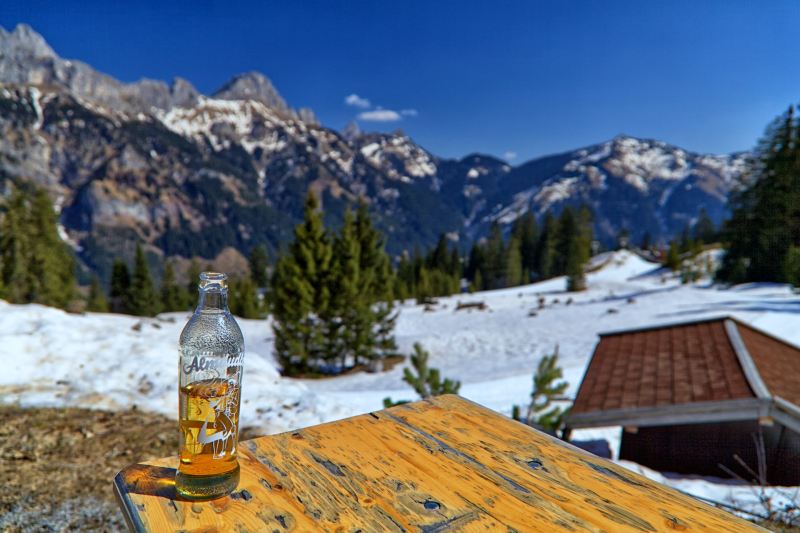
Winter is almost here and all the snow-covered, wintry activities that it entails. We’re talking about snow tubing down seemingly treacherous hills, sibling snowball fights galore, countless snow angels, and days spent downhill skiing and snowboarding. But while the latter is a great wintertime activity on its own, it’s even better when you add in the après-ski component.
Don’t know what après ski is? Well, it’s a French phrase that literally translates to “after skiing.” But instead of simply lounging and resting your aching joints after navigating every hill and completing an eight-hour lift pass (or simply after a few runs), après ski is all about the after-skiing (or snowboarding) social activities. And by social activities, we’re talking exclusively about boozy drinks.
For those new to the phrase, après ski has been around for a long time. While it started in Norway in the 1800s, it spread throughout the French Alps by the 1950s and became a way of life for French skiers. We can see why. Who wouldn’t want to enjoy a warming spirit, mixed drink, or crisp beer after a day of skiing in frigid, windy, snowy temperatures? While celebrations vary throughout Europe, French après ski consists of wine, cheese, and charcuterie. German skiers enjoy après ski with beer, warming spirits, and lively singing. Swiss après ski consists of mulled wine or champagne flutes. Some European ski resorts and ski towns have epic après-ski parties and gatherings.
Après ski might not be as over the top as it is in Europe, but that doesn’t stop Americans from enjoying a few drinks after a long day on the slopes. Some American resorts even have specific après-ski bars and saloons (some you can even literally ski into).
But you don’t need a bar or restaurant to enjoy this after-skiing tradition. Après ski doesn’t mean you even have to hit the bar at all. All you need is some glasses and a bottle of alcohol or a few cans of beer. Don’t believe us? Below, you’ll find our favorite après-ski liquors and beers. Grab some of these and head to the mountain. You’ll be glad you did.

TINCUP American Whiskey
If you’re going to enjoy après ski, you should do it right and enjoy a whiskey from a Colorado-based brand. This 84-proof “mountain whiskey” is a blend of two American whiskeys. The first is a straight bourbon distilled in Indiana and the second is an American single malt distilled in Colorado. Both were aged in charred American oak barrels. The result is a complex, memorable sipping whiskey that begins with a nose of cracked black pepper, candied orange peels, vanilla, toffee, and ginger spice. The palate is loaded with cinnamon sugar, butterscotch, and peppery rye spice. It’s sweet, warming, and pleasantly spicy. It’s a great sipper to warm you up after a day on the slopes.

10 Barrel Pub Beer
This 10 Barrel Pub Beer is about as no-frills as beer gets. It’s a 5% ABV American lager that was crafted to literally taste the way you imagine a classic glass of lager tastes. It’s beer-flavored beer, and there’s nothing fancy about this beer. That’s why we like it so much. After a day on the slopes, there’s nothing more refreshing than this floral, orchard fruit, and caramel malt-filled beer. It’s crisp and thirst-quenching, and it finishes with floral, earthy Noble hops.

Underberg Bitters
For some skiers and snowboarders, après ski is a great time to enjoy a warming digestif. A great choice is Underberg. This German bitters liqueur is made from 43 aromatic herbs and botanicals. Similar to Italian amaros, Underberg is known for its herbal, spiced flavor profile featuring anise, licorice, close, and other flavors. Typically enjoyed in a shot or a small glass, this German liqueur is sure to warm you from the inside out.

400 Conejos Joven Espadín Mezcal
Some drinkers opt for the smoky, warming flavor of a well-made mezcal after a day of skiing or snowboarding. A great choice is 400 Conejos Joven Espadín Mezcal. Distilled from 100% hand-selected Espadin agave, this popular mezcal is made using only traditional methods. It begins with a nose of roasted agave, light fruits, and a nice kick of smoke. The palate continues this trend with gently cooked agave sweetness, honey, light spices, and campfire smoke.

Argonaut Fat Thumb Brandy
Brandy can be a great choice after an afternoon or evening of skiing or snowboarding. While you can’t go wrong with Calvados, apple brandy, or even cognac, we suggest a nice American-made brandy like Argonaut Fat Thumb brandy. It’s a blend of eight Coffey and pot-still distilled brandies. They range between 2 and 16 years of maturation. The result is a flavorful, memorable brandy with notes of brown sugar, toffee, dried cherries, and caramel apples. It’s great as a mixer, but even better as a slow sipper.

JYPSI Legacy Whiskey
This award-winning whiskey is a blend of Indiana bourbon whiskey (matured for 7 to 8 years). Canadian rye whisky (aged for 20 years), and an American single malt whiskey (aged for 4 years). It’s well known for its mix of sweet corn, butterscotch, peppery rye spice, vanilla, and candied nut flavors and aromas. It’s a sweet, spicy, complex whiskey well suited for slow sipping after a long day spent on the slopes.



